Nick Travers's Blog, page 8
February 14, 2016
The sound of black holes colliding
Two black holes, the most powerful forces in the universe, collide and emit gravitational waves.
Hollywood would have them crash together with the most thunderous sound ever heard.
But the actual sound of the gravitational wave: Bloop.
A simple, elegant, pure, even beautiful, bloop. Like a pebble dropping into a deep deep well, Which in an astrophysical sense it is.
In fact, it was so elegant I laughed.
The most powerful spine on the universe:
Bloop.

February 4, 2016
Make money while writing a novel
 Earning while writing your next novel has to be the holy grail of authoring. Surely, in the age of the internet, it must be possible to earn money chapter by chapter as you write a novel. For me, this intriguing possibility reared its head when I came across Freemium publishing in China. Readers of Freemium pay per character to read the latest instalment of their favorite series. The best writers publish up to ten thousand characters daily and earn good money. Unfortunately, this only works with serials written in Chinese characters—I know because I have tried to publish on Qidian.com, but it just does not work.
Earning while writing your next novel has to be the holy grail of authoring. Surely, in the age of the internet, it must be possible to earn money chapter by chapter as you write a novel. For me, this intriguing possibility reared its head when I came across Freemium publishing in China. Readers of Freemium pay per character to read the latest instalment of their favorite series. The best writers publish up to ten thousand characters daily and earn good money. Unfortunately, this only works with serials written in Chinese characters—I know because I have tried to publish on Qidian.com, but it just does not work.
There is no equivalent earn-as-you-write platform anywhere else in the world except Japan.
While I was writing the first book in my Dystopian Steampunk series, Gaia’s Brood, I did manage to make $30 per month. I published two chapters per week on Jukepopserials.com. At the time they were awarding $30 per month to stories that received the most reader votes in each of their genre categories. I had no problem topping the Steampunk genre month after month. I would do the same again with my current novel, Coggler’s Brood, but Jukepop Serials have moved onto a different reward model.
Now monthly genre winners receive credits towards a sort of crowdfunding system where internal investors contribute towards the costs of publication and marketing, then share in the book profits. Not a bad model, and will be interesting to watch for the future—you should definitely go and check it out. However, it is not what I am looking for at the moment.
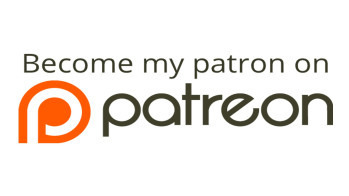 Instead, I am experimenting with a platform called Patreon.com, a crowdfunding site where investors are encouraged to pay one or more dollars per month as a patron of a particular artist/creator. In return, investors are given rewards, in my case a free electronic copy of my ebook if they contribute $1 per month or a paperback copy if they contribute $10 per month.
Instead, I am experimenting with a platform called Patreon.com, a crowdfunding site where investors are encouraged to pay one or more dollars per month as a patron of a particular artist/creator. In return, investors are given rewards, in my case a free electronic copy of my ebook if they contribute $1 per month or a paperback copy if they contribute $10 per month.
In all cases contributors will receive access to restricted chapters as I write them and in the future access to restricted stories.
For the moment, I am offering chapters of Coggler’s Brood for free as I write them, but before long, I will restrict access so only contributors on Patreon.com will be able to access them. I will still be publishing work in progress chapters on my website, but again, these will be restricted by password, where the password will only be available via Patreon.com.
In fact, before long, you will only be able to view my work-in-progress by contributing at least $1 per month on Patreon.com.
Will it work? Will anyone be interested enough in my work-in-progress to contribute anything on Patreon.com? Who knows, I will report back on progress in the future.
In the meantime, if you would like to become a patron of the arts, you can contribute as little as $1 per month at Patreon.com…
Please support the work of this writer by buying his works, pledging a monthly amount in return for rewards, or by donating below via Paypal.

December 4, 2015
Steampunk or Steampulp
 Recently I have been challenged on whether I can correctly use the term ‘Steampunk’ when referring to my novels Gaia’s Brood and Coggler’s Brood.
Recently I have been challenged on whether I can correctly use the term ‘Steampunk’ when referring to my novels Gaia’s Brood and Coggler’s Brood.
Am I misusing the term Steampunk in my writing? Am I, like many authors, just jumping on the Steampunk bandwagon? In fact, has Steampunk become no more than a marketing term?
Steampulp is a new one on me, but I do have to confess to liking the term. I am not ashamed to admit that I write pulp fiction. In fact, I rather take pride in the title: to me it means popular, fun, literature that is produced by someone working hard at their craft. It also suggest that stories are produced as a series.
Just because I am churning out pulp serials does not mean I am not also, in some small way, trying to challenge concepts, taboos, or accepted culture. I am fascinated by the reasons people do things, so I try to examine this in my novels. The stories in Gaia’s Brood and Coggler’s Brood are very much character driver: Why is Nina Swift obsessed by the mother who abandoned her? How far will Nina go morally to prevent a massacre? To what extent will Fernando rebel against his family before he is reined in by the need for their money? How does Scud’s simple black-and-white view of the world affect the
As I have said in a previous article, the internet has ushered in a new golden age of serialized (or pulp) fiction. Any writer, by sheer hard work, can now use the world wide web to bypass the publishing industry’s gatekeepers, build an audience, and make money from writing. The internet also allows authors to service readers with niche interests, who are perhaps ignored by traditional publishers in their thirst for works with mass appeal. A genuine readership of 4000 fans should be enough for any author to make a reasonable living, provide they keep churning out the stories their readers like.
Technically, I should not even be using the term ‘Steam’ in my writing, since in the post-apocalyptic, post carbon fuel, dystopian future I use as the setting for Gaia’s Brood and Coggler’s Brood, steam power features hardly at all. It would be more accurate for me to term my novels Post-apocalypticpunk, Dystopianpunk, or, Ecopunk (have I just invented a new genre?), though, to be fair, I do use the strap line ‘Dystopian Steampunk’.
Except that these terms are far too specific to reach the audience I am attempting to reach.
As for the ‘Punk’ in Steampunk it suggests a general sassiness on the part of the main heroine, Nina Swift, rather than having anything to do with the anti-establishment music scene of 1970’s and ‘80’s. Many of the characters in my novels have this pop-culture sassiness of character, that you might associate with steampunk comic-strip or cosplay characters.
For Gaia’s Brood, when I was originally writing the book as a serial, on Jukepop Serials, I just called it dystopian fiction, but then it got adopted by steampunkers looking for something new to read. So, like any good artist, I started to deliberately add in steampunk themes, fashions, architypes, and tropes, to satisfy my readers.
In a very general, genre-based sense, Steampunk suggests a retrograde scifi story without masses of future tech. I have written before about the problem of including future tech in your stories that then become dated even before the novel is published. For me, this partly explains the emerging popularity of ‘Steampunk’ stories, both among writers and readers. Who want’s their escapism ruined by the encroachment of reality? There is far too much tech stressing us out in real life to also desire it in our fantasy worlds – escapism should be a shelter from the stresses, strains, and anxieties of the real world.
So, back to the original question: Steampunk or Steampulp? I am very happy to use the term Steampulp, though, it would rank very low on search engines and need, I feel, more explanation than the term Steampunk.
However, given that ‘Steampunk’ was originally a tongue-in-cheek term coined to describe a very loose collection of retro-futuristic scifi writings that did not easily fit into any other genre, I still feel justified in using the term to describe my retro-futuristic dystopian novels.
So, I do not think I am misusing the term Steampunk to describe my writings. And yes, I am jumping on the Steampunk bandwagon, because I feel it is a response by the scifi genre to rampant technological advancement. And yes, of course it is all about marketing, and branding, and finding an audience – because the only thing worse than being a Steampunk writer, is being a Steampunk writer without an audience.

November 5, 2015
How to Create Meaning Through Story
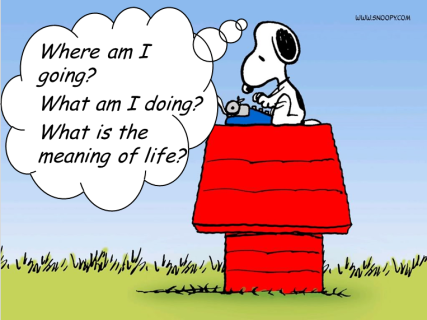 What is better than creating a novel that delights and entertains your readers? Maybe creating something that addresses the deep questions of life – something with meaning.
What is better than creating a novel that delights and entertains your readers? Maybe creating something that addresses the deep questions of life – something with meaning.
Not every writer strives for meaning in their work, but if you dream of having an impact on the world, however small, through your writing, then meaning is what you are after.
All stories, no matter what their subject, are ultimately about the human condition.
The first step to creating meaning is to choose a theme for your novel. This is not the same as creating your plot, which may have nothing directly to do with your theme. For instance, in my second dystopian steampunk novel, Coggler’s Brood, the plot is about Nina Swift, the protagonist, trying to deliver a package given into her care, which is the Mcguffin (see related post), but the theme is, ‘How far will Nina go to thwart her mother’s evil plans.’ In essence, I am exploring Nina’s morals – will she stoop to the monstrous depths of her mother in order to overcome her mother, if not, how far will she go?
The theme will, of course, have a direct impact on the plot: Initially, the theme will be hardly noticeable and the plot devises will dominate, but by the end of the novel the entire plot will revolve around the moral theme and Nina’s moral choices.
Working the theme into the plot is a relentlessly subtle process with one golden rule: you can never actually state the theme, or, for that mater, have a character state the theme. For a satisfying reading experience, the reader must discover the theme for themselves – they must extrapolate the theme from the actions and character development of the novel in its entirety, i.e. the theme must be expressed and developed through ‘showing’ not ‘telling.’
Ideally, the aim of Coggler’s Brood is to leave readers pondering their own morals and questioning how far they would stoop to save the world, but it may just leave them wondering how much they are like their parents and questioning whether this is a good thing or not. In either event, I, the author, will have had an impact on the world.
Writing: changing the world one reader at a time.
Tweet this!
Whether you weave your theme into the story by plotting it out first or by adding it in at the final edit, is irrelevant, but you must do it. Whatever stage you do it at, there are three question that must be addressed for every action and piece of dialogue in the novel:
How does this action/dialogue advance the plot.
How does this action/dialogue advance the theme.
How does this action/dialogue advance character development (this question may apply to one or more characters or every character).
Developing the theme of a novel is a subtle and relentless process that is learned through experience. I don’t claim to be an expert, far from it, but I’m going to keep striving, one novel at a time, until I perfect the techniques, because I want my writing to have an impact on the world.
In researching this blog, I found an excellent article from Julia Bell which expands on themes much better than I can. So I will eave you, with full credits and links, the relevant points from Julia’s Blog:
Nick
Extract from a blog post by creative writing lecturer Julia Bell.
 “Sometimes as a teacher you feel like you’re trapped in a groundhog day, repeating the same pieces of advice every year, just to a different cohort of students, although as I get older and more forgetful perhaps I’m just repeating myself and students are being too polite to call me on it.
“Sometimes as a teacher you feel like you’re trapped in a groundhog day, repeating the same pieces of advice every year, just to a different cohort of students, although as I get older and more forgetful perhaps I’m just repeating myself and students are being too polite to call me on it.
In any given year these are the pointers about writing good prose – novels and stories – that I find myself saying over and over, but they are also in themselves, light bulb moments from my own practice as writer.
1. A good piece of writing is an experience for the reader. The meaning of a story or a novel does not pre-exist the writing of it. You can’t write with a manifesto in your hand unless you are intent on writing parables or sermons. Technique – point of view, character, sentence structure, style – are all in service to the creation of this experience.
2. The writing of a story should be an experience for the writer too. The work needs to transmit something – love, anger, jealousy, rage, disturbance, (add your own abstract noun here) – but you can’t experience these abstractions in prose just by using the abstract noun. In fiction, meaning is delivered through concrete detail and description. Don’t tell me that your character is angry, show them throwing the ashtray. As a rule of thumb if your work makes you feel – cry, laugh, explode – chances are it’s transmitting something of this to the reader too.
3. Make your story question the world. A story should never set out to answer a question, rather it should pose the question correctly. Here I am paraphrasing advice from Chekhov. Good writing offers up a knotty picture of the world for a reader to untangle: Over here, reader! Look at this tangle of thorns! A story which ties everything up in neat conclusions might be more commercial (read Disney) but if it doesn’t make us question the world then it cannot claim to be art.”
Julia’s post first appeared on the On the Write Track blog, where you can read the article in full
.
About JULIA BELL
 Julia Bell is a writer and Senior Lecturer at Birkbeck College, London where she teaches on the Creative Writing MA and is Project Director of the Writers’ Hub website. She is the author of three novels, most recently The Dark Light to be published in July 2015, the co editor of The Creative Writing Coursebook as well as three volumes of short stories most recently The Sea In Birmingham. She also takes photographs, writes poetry, short stories, occasional essays and journalism, and is the co-curator of spoken word night In Yer Ear. Follow her on Twitter at@JuliaBell.
Julia Bell is a writer and Senior Lecturer at Birkbeck College, London where she teaches on the Creative Writing MA and is Project Director of the Writers’ Hub website. She is the author of three novels, most recently The Dark Light to be published in July 2015, the co editor of The Creative Writing Coursebook as well as three volumes of short stories most recently The Sea In Birmingham. She also takes photographs, writes poetry, short stories, occasional essays and journalism, and is the co-curator of spoken word night In Yer Ear. Follow her on Twitter at@JuliaBell.

September 4, 2015
Why writing what you know doesn’t work
 “Write what you know!” is not only the most useless piece of fiction writing advice I ever received, but for decades it prevented me from writing anything at all.
“Write what you know!” is not only the most useless piece of fiction writing advice I ever received, but for decades it prevented me from writing anything at all.
Instead of writing what you know, let me show you what your readers really crave. Something that, uniquely, only you can provide.
For years, even though I had masses of ideas circulating in my head, I never wrote anything, because I thought I didn’t know anything worth writing about. Later when I did know stuff, it was so boring even I didn’t even want to read it.
The story that changed everything.
I’m a great fan of Wattpad.com. It’s a writing platform where youngsters publish, comment, encourage, and critique each other’s stories. Anyway, there was this one story about domestic abuse that was badly written, contained bad spelling, and had hopeless grammar. The plot was pretty lame too, but I was immediately captivated.
The central character, by necessity, had one public persona and one private persona, which was intriguing enough, but the things that really drew me in were the emotions. It was clear this young writer had personally experienced the difficult and horrific things her protagonist went through: she knew what she was writing about.
As the story unfolded and eventually came to a stuttering standstill, we got to know a little bit more about the author herself. It became clear she was still trapped in some of the difficulties her protagonist had left behind, and one day she too hoped to find the courage to escape, just like her heroine.
The story, however, was just a story. The author had deliberately chosen a setting, characters, family members, protagonist and a villain that would in no way identify her, her situation, or anyone remotely connected to her. The only things of the author that remained in the story were her emotions and experiences, and the story was perhaps all the more powerful because of that.
That young author on Wattpad taught me a valuable lesson that opened the floodgates of my own creativity. Inadvertently, she had done what all good writers do: she wrote from her own emotional experience, about things she had known.
Don’t write what you know; write what you’ve known.
Tweet this!
Everyone has a story to tell, right?
True, but mostly it’s in a mundane setting with boring characters and a story line that winds and rambles until it makes some sort of sense to the protagonist, but not necessarily anyone else.
However, take the experiences you have known, the dilemmas you have struggled with, the hopes and fears you have faced, and the emotions you have experienced, put them into a story and you can create something special.
The best stories, the ones that grab us, affect us, and change us, are the ones that contain the heart and soul, and emotions, of the author: where the author writes, in story form, what they have known. In that sense, all stories are about the human condition, and all stories are autobiographical.
I hope that young author, who taught me a valuable lesson about my craft, did somehow find the courage to escape her situation. Because, stories, if they contain real emotions and experiences, are powerful, and can change us. I like to think that perhaps she was changed by her own stories.
Here is how you construct a compelling story.
Choose an interesting setting/time period/place/genre.
Populate the setting with a cast of memorable and intriguing characters.
Choose an exciting plot and decide how it will end.
Choose an emotional issue/problem from your life to be the overall theme of your story – this is how your protagonist(s) will change and develop emotionally over the course of the story.
Identify the exact opposite issues/problem from the main theme – this is how your antagonist(s) will change emotionally over the course of the story. I have found the books, “The Emotion Thesaurus” and “The Negative Trait Thesaurus,” both by Angela Ackerman and Becca Puglisi, to be very useful at this point.
To make an interesting story, and enable you to explore the issue emotionally through your main character(s), you must prevent the plot progressing smoothly (and boringly) by exaggerating the obstacles and difficulties you have faced in relation to that issue. Then throw in a load of even more extreme, made up, obstacles for your protagonist(s) to overcome. The obstacles should increase in difficulty as the story progresses, which creates the story.
Finally, steer your story to your chosen conclusion, which may or may not resemble the outcome you yourself had from the main issue/problem or may be an extreme version.
Suddenly you have a story that is not only unique to you and the emotional life experience you have known, but everyone wants to read it. Why? Because, regardless of everything that is made up (fake) about the story, the emotions and experiences are still real: they feel real because you have known them, and readers connect with you for that reason. You are still telling a human story, your story, just through different characters and in a different setting.
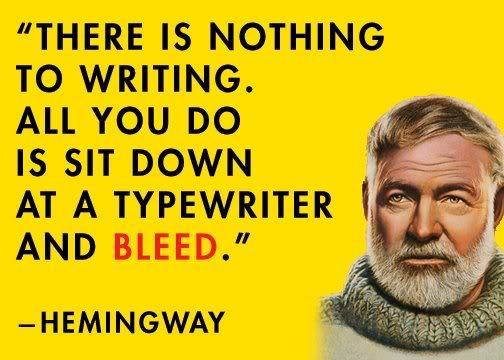
Okay, so it’s no where near as easy to do well as I make it sound, and Hemingway is probably closer to the truth: to write well you do need to bleed emotionally, because is can be a painful process as well as an exhilarating one. The best writers can take an issue and open it up through fiction in a way that may be impossible through any other means.
So remember, to create a good story, don’t write what you know; write what you have known.
Happy (or at least productive) writing. Nick.
Please support the work of this writer by buying his works or by donating below via Paypal.

August 7, 2015
A Town Called Story

I’ve discovered a brilliant new TV programme which I am totally mad about. It’s a scfi show by the name of, A Town Called Eureka, about this fictional American town populated entirely by scientific geniuses.
Before anyone says anything, yes, I know it was cancelled in series five in 2012, because it didn’t make “enough profit,” but I’m seeing it for the first time so let me enjoy it.
As scfi programmes go, it has more than it’s fair share of ‘rubber science’ [https://en.wikipedia.org/wiki/Rubber_...], all delivered with intense fervour and absolutely straight faces – the writers must have had fun making up all those pseudo scientific terms.
Whilst the premise is about super-smart people doing super-smart science, there are a few things that set this programme apart form others of its ilk:
Memorable and well crafted characters – all the main players are almost caricatures of themselves, but not quite.
The series does not take itself too seriously, e.g. the android deputy sheriff has a stupid grin on his face all the time and an annoyingly chirpy attitude.
The weekly storylines always concern themselves with the relationships between the different main characters, and the scientific storylines nearly always provide the barriers, stumbling blocks, and challenges that move the relationship stories along. The result is that you really get to care about these characters and their bizarre lives.
This fantastic story telling and clever writing, which provides a TV equivalent of an intoxicating page turner. I intend to track down the series writers and see what else they are working on.
I am also resolved to adding more character relationship storylines to my future novels, which are fed and powered by the main plot. This will be difficult and I’ll need to tweak the plot lines to facilitate this, but I reckon that if I can resolve one relationship storyline every three to six chapters I will increase the appeal of my stories exponentially.
If you have experience of this kind of writing, please provide some details in the comments.
Please support the work of this writer by buying his works or by donating below via Paypal.

July 16, 2015
Writing Workshop – Twitter Strategies for Longtail Book Marketing
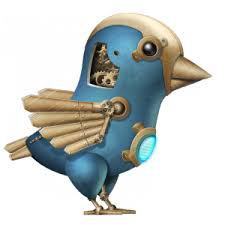 I use twitter in a number of ways. Again, as I’m using a pen name, I can set a theme for my twitter account. So most tweets and images have a loosely steampunkish feel to them, except for a few that are overtly about writing. I even managed a steampunk theme for this twitter image.
I use twitter in a number of ways. Again, as I’m using a pen name, I can set a theme for my twitter account. So most tweets and images have a loosely steampunkish feel to them, except for a few that are overtly about writing. I even managed a steampunk theme for this twitter image.
When setting up your twitter profile, remember, you are not necessarily looking for like-minded people; you are looking for people who like what you are selling/promoting. This is the place to set the tone for your niche/genre, because people are going to read this to decide whether they should follow you or not: your profile is your first line of attack in targeting your audience.
Next, pay close attention to the photos attached to your tweets. The quickest way to discover what someone is really about is to look at their photos, because these are the things they themselves have tweeted about. If someone has followed me and all their photos are about cats, I might question whether anything of mine they retweet is going to have a very high impact amongst all that fluff. Even on twitter pictures speak louder than words, so actively managing the photo content of your twitter account, to support your theme, is important.
Finally, set up an automated reply for anyone who follows you and offer them your best freebie. I may be totally wrong about this, but it seems to me that if someone has taken the trouble to click on one of my tweets, check out my profile, and decide they want to follow me, then that is the point when they are most engaged with me or my novels. So this is the point when I want to offer them a free gift. I use a free ebook from my scifi series (not ideal when promoting a steampunk novel, but I will replace it with a free steampunk prequel novella as soon as it is completed).
I use a programme called Crowdfire for my auto-responder follow reply because… yeh, you guessed – it’s free, and it works well on my mobile. This programme also enables me to unfollow anyone who does not follow me and weed out those who do not use their twitter accounts regularly – more about that later.
One of the things I really like about Twitter is I can easily use it on my mobile. In fact nearly all my twittering is done via a mobile – either last thing at night or first thing in the morning, or during those unproductive few minutes when nothing else is happening.

When it comes to marketing your book, ignore whatever anyone says about Twitter being about social networking: Commercial twittering is a numbers a game. It is all about finding the highest number of like-minded followers – within Twitters rules, of course.
Finding followers on twitter is easy, but you may want to be selective about who you follow. Here is my follow criteria:
I actively look for people who are: readers, writers (because they generally read a lot too), steampunkers, cosplayers, tea drinkers (often a code for an interest in steampunk and/or victoriana), whovians (fans of Dr Who), tinkerers, indie publishers; also those into: victoriana, cogs, gears, historical romance, anamie, comics, films, graphic novels.
I do not follow: companies, company CEO’s (because they’re basically the same thing), accounts without a profile picture, accounts with no profile description, glamour, celebrities, and writers of erotica. In addition, I always block porn accounts and accounts selling twitter followers. Who you choose to follow says a lot about you and your product. Again, your criteria should be based on your target audience.
Finding Followers
 There are two main ways to find followers on twitter, a process commonly known as ‘farming':
There are two main ways to find followers on twitter, a process commonly known as ‘farming':
The first method is to find someone selling books in your niche and/or genre, and follow their followers, applying your follow criteria. Following someone on twitter is a bit like waving a flag and saying, ‘Here I am, come and have a look,’ they will either have a look and decide to follow you or not.
Initially, twitter limits the number of people you can follow to 2000, but also generally prevents you following 10% more than the number of people following you. This means you somehow have to identify who, of the people you have followed, has not followed you back. I use the same programme as I do for my automated follow replies, Crowdfire. For free they identify people who have not followed you back and they allow you to delete up to 100 per day. It also works well on my mobile. Other providers offering a similar service are available – pick whichever suits you and your devices.
Now, no one wants to follow someone who is following masses more people than are following them (I know it’s hypercritical, because most people on twitter are out to get as many followers as possible, but that’s just human nature), so unfollow anyone who doesn’t follow you within a reasonable time (I allow a week). This also ensures you have a good quality follower base, both for your own purposes and because, believe it or not, some of your followers with a similar interest will want to farm your followers, which is good because…
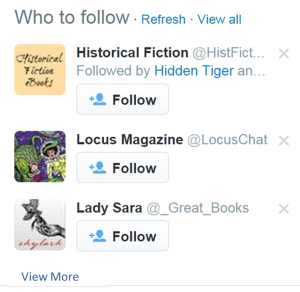 The second method of finding followers is to accept the suggestions made by twitter. These suggestions are based on people who are followed by some of your other followers, people with a similar interest that you haven’t yet found. If you are on a the mobile app, find the suggestion list with a ‘view more’ button, click it and you get to see the profiles of their followers. On a pc there is only one suggestion list which has a ‘view all’ button at the top.
The second method of finding followers is to accept the suggestions made by twitter. These suggestions are based on people who are followed by some of your other followers, people with a similar interest that you haven’t yet found. If you are on a the mobile app, find the suggestion list with a ‘view more’ button, click it and you get to see the profiles of their followers. On a pc there is only one suggestion list which has a ‘view all’ button at the top.
Again, apply your follow criteria. In fact, for the best quality twitter suggestions, you should rigorously apply your follow criteria at all times and actively weed out non-followers and non-active accounts. You will also become a quality source for like-minded people to farm your followers, but to do that they first have to follow you, giving you access to their followers. Actively managing your follower base means the whole thing slowly builds like a pyramid of quality cross-referrals. This is also why you should never buy twitter followers, because diluting the quality of your follower base will have long-term knock-on effects on quality. You quickly get used to assessing the likely fit of someone’s followers to your criteria. And, given the millions of people on twitter and the limits to your own time, you soon ditch anyone with a polluted follower base.
Generally, I provide a retweet for a retweet, and a favourite for a favourite. This seems to suit the transactional nature of twitter without me getting too bogged down in personal conversations (I have these too, but not in anything like the numbers required to build a marketing base).
What to retweet or favourite from other people’s accounts often presents a problem. I try to select stuff that is in keeping with the theme of my twitter account, but I am still surprised how difficult this can be sometimes. If I have scrolled down a few times on a person’s account and still found nothing original from them, I automatically go to their photo section. If they are promoting something or have any sort of purpose to their account, this is where you should find it (most people are promoting something, even if it is just their personal world-view or pictures of their cat).
So make sure you send out your best tweets with a picture attached, that way they will automatically end up in the photo file of your twitter account for your followers to re-tweet on your behalf. However, every follower can only re-tweet or favourite each of your tweets once, so make sure there are enough original themes tweets in your photo file for your followers to re-tweet many times. I find it amazing how even the most prolific of tweetwers shoot themselves in the foot by having only a few original tweets that I can easily access.
Lots of followers mean lots of people see my tweet, right? Wrong.
This is the bit about twitter that is rarely mentioned: just because you have 5,000 followers does not mean all 5,000 followers see your tweet. Imagine one of your followers is standing beside a busy eight lane highway, the cars racing past are the tweets from all their followers. Somewhere, in that mass of speeding vehicles, your lone tweet flashes past. What are the chances of that follower seeing your tweet? Probably not a lot.

Luckily, Twitter Analytics gives us some accurate data, if you are brave enough to look. First the good news: your 5,000 followers gives you a reach of 90,000 twitter accounts, also, your three tweets per day were viewed a total of 20,000 times in a twenty-eight day period – sounds impressive doesn’t it?
Now the bad news: the statistics per tweet are vanishingly small. In fact, the figures are so depressing that I have hidden them on a separate page – you can link to them here if you must. But you really, really, really don’t want to.
To save your sanity, the conclusions from the math are these. To sell anything other than a handful of books, you must:
Have a good themed website to engage you potential readers.
Tweet about the articles/themes on your website.
Tweet regularly.
Never stop accumulating twitter followers – aim for 50,000 followers as a basic number.
Spend the majority of your valuable time writing more blockbusters, because in the long-term it is a better use of your resources.
Regular tweets.
To send regular tweets over a sustained period you need some sort of automation. This is difficult, because Twitter don’t allow tweets to be automated. Finding a free app that will automate tweets is even more difficult.
Hootsuit.com and similar services, let you pre-schedule tweets, which is useful for an intense marketing campaign, like a book discount, where you want to send out an avalanche of tweets per day. However, you have to set up each individual tweet separately, which even with cut-and-paste is tedious in the extreme. This effectively limits the number of tweets you can send, which is exactly what Twitter desire. Also, something to be aware of is that photo tweets from Hootsuite don’t go into your photo file.
A better solution for regular tweet activity, is to use Buffer which can also work off the chrome browser. This lets me set up a total of ten tweets which are released at set times. Ten doesn’t sound too many, but if I set it to send three tweets per day that is three days-worth of twitter marketing taken care off. I find this number also creates a manageable response rate in the form of re-tweets, favorites, and follows, without detracting too much from my writing time.
However, the best bit about Buffer (apart from being free) is that when I want to set up new tweets, I just enter the analytics section, scroll through the sent tweets, and select which ten tweets I want to resend over the next few days. Twenty or thirty quality tweets, that I can easily reset, is all I need to build relationships with my existing fans and attract new followers.
The Buffer app also works well with my mobile so I can complete the setup operation in a spare moment every three days or so. I also tend to move the delivery times forward by an hour every time as this increases the chances of different followers seeing the next batch of tweets. As an additional benefit, Buffer photo tweets also go into my twitter photo file so I always have a ready supply of quality tweets for my followers to re-tweet.
I find that Buffer makes it particularly easy for me to sustain low level (minimum) twitter marketing, on top of which I can build more intense marketing campaigns when I have the time and energy. Or build personal relationships.
Twitter, combined with Buffer, may not sound like a formula for conquering the world, but it does drive a steady flow of readers to my website and meets my original five marketing aims:
Have a low impact on my writing time
Have low cost
Be Scalable
Be Sustainable
Have a low impact on the rest of my life
It also reinforces my marketing mantra:
Market slow; write fast.
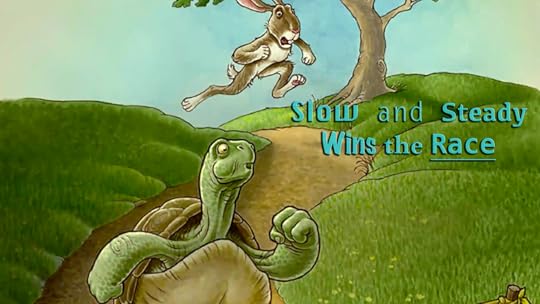 It takes a long time to build a good follower base on twitter: you can’t attract 50,000 followers overnight – think more in terms of a year or two to build your follower base. Keep it steady, keep it sustainable, and keep on writing, so that when your follower base matures you will have a trilogy of novels to offer.
It takes a long time to build a good follower base on twitter: you can’t attract 50,000 followers overnight – think more in terms of a year or two to build your follower base. Keep it steady, keep it sustainable, and keep on writing, so that when your follower base matures you will have a trilogy of novels to offer.
I hope you have found this article to be useful. If you have other twitter marketing technique you would like to share, please leave detail in the comments section, because I would love to hear about them.
Next time, I will talk about how I use Wattpad, which is very different from Twitter.
Please support the work of this writer by buying his works or by donating below via Paypal.

July 9, 2015
Writing Workshop – Website Content for Longtail Book Marketing –
Remember what I’ve said in previous posts about finding a niche for your novels, well how your novel serves this niche is your brand. Everything about your website should appeal to that niche audience. In other words, you need to write interesting things on a theme/themes that fit in with the books/novels/series you are promoting. If people are interested in your theme(s) they might be interested in your novels, and visa-versa.
A brand is more than just a novel; it is a whole experience. Tweet this!
I use WordPress.com for my NickTraversAuthor.com website because it is free and does the job – WordPress.org would be slicker and has lots of useful integrated widgets, but it needs hosting which costs money. WordPress.com, with a few workarounds, is good enough for me. (Other website providers are available, I just happen to use this one because it works for me. If you use another, by all means provide details in the comments section of this blog).
Oh, and did I mention WordPress.com free? Arguments about me being a skinflint aside, free is actually an important consideration, because I am running a business here, which means anything I spend on promoting my novels has to come out of profits from sales. Also, as I said in the first post in this series, any of my book profits I spend on marketing, and a website is definitely a marketing tool, potentially detracts from the quality of my next novel. If I didn’t take this approach, I would be supporting a hobby – which is fine if that is what you want to do, it’s just not my particular aim.
My website, NickTraversAuthor.com has three thematic elements:
Steampunk – anything about the world of steampunk that I find interesting
The Steampunk world of Nina Swift – ideas, things I am researching, or creating for the steampunk world of my protagonist.
Free writing advice – potted blogs on what I have learned about the craft of writing/story-telling, with plenty of linked examples to my own novels. I tell it like it is, warts and all: no hype, no frills, no romance, no conns, no subscriptions, no charge.
There are also pages where I sell my books, give away freebies, and present ways to earn money (I offer 50% commission through an affiliate scheme to anyone who wants to promote my books). These last two pages are the most visited on my site. One thing I have learned from the awesome Derek Murphy, is to give away lots of things with real value. I wish I had more to give away, but these will grow as I write more books and build the writing business.
The aim for a themed website, is to have lots of interesting articles that your potential readers will want to learn/read about. This is all about creating buzz for your theme and giving content away for free. It is also known as Content Marketing.
I’m aiming for a minimum of twenty-five articles on my website, of two-thousand words or more. The articles are then published on stand-alone pages on the website so I can direct traffic straight to that article. At the end of each article suggestions are offered of other similar articles on my website.
I am careful to include examples and illustrations from my own books in each of the articles and blog. The theory being that if a reader gets to know my writing and my books a little, they may want to investigate further and buy the books.
Shorter articles, of less than two thousand words, like this one, are published as regular (or in my case irregular) blog posts. Apparently, the Google search algorithms like articles to be more than two-thousand words in length – I have no idea if this is true, but it sounds to me like a reasonable length for a good in-depth article.
Sometimes, several blog posts on a common theme can, at a later date, be combined to make up a full article.
Most of my blogs fall into two categories: those with Steampunk in the title, or those with ‘Writing Workshop’ at the start of the title, but I also include other stuff in the blogs (Like this article) just because I find them interesting and to show that I am really human.
Once you have a blog set up you can embed it into other services. The only place I do this is on my Goodreads.com account, where I get a lot of ‘friends’ linking to my blog. The only reason I do this for Goodread.com is because I write and sell books and their audience read books – sounds like an ideal fit. Let me know in the comments if you link your blogs to other fruitful services.
Mailing lists, I am told, are absolutely vital to selling new books as they are published and drawing attention to special discounts. These are email addresses of your diehard fans. I offer readers the opportunity to sign up for a VIP emailing list so I can send them interesting stuff in the future, like newsletters, exclusive stories, and details of new publications. I also have individual sign-up lists for many of the free offers, such as ‘free books in return for honest book reviews’. This enables me to set up automated email responders to instantly deliver the relevant discount codes for their free offers, etc.
WordPress.com lacks any widgets for auto-responders, so I use a third-party programme called Mail Chimp. Mailchimp.com not only allows me to collect readers email addresses, but also allows me to set up an auto-responder ‘thank you’ letter (with discount code included). They also allow me to target my email lists with limited auto-responder campaigns (news letters, etc).
For me Mail Chimp has two distinct advantages for me over its rivals: it is free at the volumes I am using (by now you know how much I love free), and I can download my email lists to store on my own computer – control of my own email lists is an absolute, non-negotiable, must for me. (Other email aggregator services are available. If you use another, by all means provide details in the comments section of this blog).
Now, because WordPress.com will not allow me to embed the MailChimp.com sign-up forms into my website, I need a workaround. Once I have finished the design of my Mail Chimp sign-up forms, in MailChimp.com, I take a screen shot of the finished product, clip it and turn it into a photo, then post it into my webpage text at WordPress.com, then hyper-link the picture of the form to the active Mail Chimp sign-up form.
When a reader clicks on the form to start filling it in, another copy of the form appears in a new window for them to complete. Not quite as slick as an embedded form, but pretty close.
I use the same workaround for videos, because I cannot embed them either – in this case the picture is hyper-linked to my YouTube channel.
I also use this workaround on a new feature I have only recently added. A reader asked if they could make a donation to support my site, so I have added pictures of ‘Donate’ buttons to my site. This is only linked to my Paypal.com account, because linking to merchant cards (Visa/Mastercard etc) is far too expensive. So at the bottom of every article and blog about writing I now add the words, “Please support the work of this author by buying their works or donating below via Paypal.” It never occurred to me that people might like to support the free stuff I provide by giving a donation, but I guess if you don’t ask you don’t get.
Another cool feature I include, is a ‘Tweet this’ options on selected short sentences within the blog or article. Again, there is a widget for this in WordPress.org, but nothing in WordPress.com, so what you need to do is add a piece of additional HTML coding to your blog as a workaround.
It took a while to track this code down, so to save you the trouble here is. http://twitter.com/home/?status= It took a while to track this code down, so to save you the trouble here is. http://bit.ly/1IT9KAx via @njtravers” target=””_blank””>Tweet this!
This is what it looks like in the blog:
It took a while to track this code down, so to save you the trouble here is. Tweet this!
Obviously the ‘via @njtravers’ bit will be your twitter handle not mine.
This has turned into a longer post on websites than I expected. If you have any other useful workarounds for Wordpres.com, or cool features, or experience with other website providers, I would love to hear about them in the comments below.
Next time I will talk about how I use Twitter to drive traffic to my website and Amazon books.
In the meantime …
Please support the work of this author by buying their works or donating below via Paypal.

July 4, 2015
Writing Workshop – The Practicalities of Longtail Book Marketing
 In the last post I shared my thoughts on the theory of longtail book marketing. In this post I will explain how I put that theory into practice.
In the last post I shared my thoughts on the theory of longtail book marketing. In this post I will explain how I put that theory into practice.
The social web (web 2.0) is the gift that makes internet self-publishing possible. Social networking drives the self-publishing world; without it, indie authors would be all but invisible. And as we all know, invisible means irrelevant.
However, there are so many good social networks out there –facebook, twitter, pinterest, instagram, etc – how do you choose which ones to use?
Some publishing sites (the ones usually selling you a service) suggest you must have a presence on all the main social networks. This, I believe is a mistake, unless you want to spend the rest of your life doing nothing but socializing on the internet, in which case go ahead. I, however, have a life outside the internet, so I need to narrow the field a little. But which ones are best? The answer, I believe is this:
Market your books on whichever social networks your target audience use.Tweet this!
Wait! You mean I need a target audience? But I write for everyone.
If you truly have a good, well written book that will engage a generic audience, don’t self-publish. Novels with generic appeal are exactly what the publishing industry are looking for. However, if you are self-publishing, a target audience will certainly help narrow your aim when it comes to marketing. Yes, you may need to edit your manuscript again to make it fit a specific genre or niche, but it will be worth the extra effort in the end. Remember, Amazon still make the majority of their publishing profits from specialist markets.
The internet is a brilliant tool for selling to niche markets.Tweet this!
 There are plenty of comparison sites out there to inform you who uses what social networks. So do some research, but keep one thing in mind: you are looking for a marketing tool for your business, not a network that will win you a personal popularity contest. In fact, I would strongly recommend you separate your writing accounts from your personal accounts. I use a pen name, but if you have already published under your own name it will be too late for that, so maybe you can set up accounts under the book / series / character name instead.
There are plenty of comparison sites out there to inform you who uses what social networks. So do some research, but keep one thing in mind: you are looking for a marketing tool for your business, not a network that will win you a personal popularity contest. In fact, I would strongly recommend you separate your writing accounts from your personal accounts. I use a pen name, but if you have already published under your own name it will be too late for that, so maybe you can set up accounts under the book / series / character name instead.
I use only two social networks, which is about as much as I can manage. These are Twitter and Wattpad, and there are good reasons why I use both: I find my dystopian steampunk stories have two natural audiences: a young adult audience, looking for dystopian fiction, and a more mature 40+ audience looking specifically for steampunk.
My two audiences tend to use different social media: young adult dystopian readers are often found on Wattpad, and the more mature steampunk readers are often found on Twitter. Both audiences almost certainly use other social media too, but I find I am most comfortable with these two networks for my commercial activities. Interestingly, both audiences are mutually exclusive: very few of my followers have accounts in the other network. Twitter is the network into which I put the main effort.
After some experimentation, I have worked out how to use these networks effectively and in a way that fits with the rest of my life. The lifestyle fit is important to me if the marketing effort is to be sustainable, low impact, and scalable, see my previous blog: The Theory of Longtail Book Marketing. Both networks require different techniques to achieve the same goal.
The first thing for an author to learn about Twitter is this: it’s useless for selling books. Sending out a stream of tweets saying “Buy my book. Buy my book,” is like hitting your head against a brick wall. However, Twitter is brilliant at driving traffic to a website (95% of all traffic to my website is via Twitter), and you don’t even have to worry about search engine rankings for your website and Search Engine Optimization (SEO).
In the next blog in this series, I will explore suitable website content for longtail book marketing, before returning to the use of twitter in conjunction with a website.

June 25, 2015
Writing Workshop – The Theory of Longtail Book Marketing

When it comes to marketing I’m no expert, but I’ve been doing it for a little while now and although my books are not selling in huge volumes they are selling at a steady trickle, so in the next couple of blog posts I’m going to explain my book marketing strategy.
I bill myself as a part-time author, because I have a life, a job, children, and other businesses. My dystopian steampunk novel, Gaia’s Brood, is not my first book or the first I have put on sale. It is, however, the first book I have produced on a commercial basis, treating writing like any of my other businesses.
I’m going to be totally honest here: sales are steady, but not great – they will pick up after I have added two more novel length books to the series and a free prequel novelette, because that is the nature of internet self-publishing. Please don’t expect anything big from a single novel, despite what everyone advertises, unless, of course, you are a hidden genius. And certainly don’t part with any sizable amounts of money, because there are a lot of people out there who have discovered it is easier to separate you from your cash, by selling you the self-publishing dream, than it is for them to realize the dream themselves – self-publishing has been called the next great gold rush.
Paid for marketing does sell books, but the amount of money you need to spend on publishing is loosely proportional to the quality of the book. Of course, if you are that one in a million genius, you still won’t have to spend much money, because viral publicity will do the job for you.
So how do the other 299,999 pulp fiction writers, like me, with fun, but average books/stories do effective marketing? (I am ignoring the 250,00 writers who never finish their first book and the 475,000 who only ever write one, because no amount of marketing will magically create a writing career – only sustained hard work will do that – sorry, the hype is lies, hope you haven’t spent too much).
Market slow; write fast; target a specific audience.
I could be completely wrong here, but let me explain what I mean by ‘Market slow; write fast’:
For me, marketing must:
Have a low impact on my writing time
Have low cost
Be Scalable
Be Sustainable
Have a low impact on the rest of my life
Here’s the explanation:
Nothing sells books to readers like more fun books in the same series, so the most effective and cost-effective method of selling books is to write more. As far as I am concerned, anything that detracts from the sacred writing time is bad business, and that includes marketing.
I may be just a skinflint, but it seems to me that instead of spending my writing profits, however small, on short-term marketing, I should be investing them long-term on producing a high quality next book (hiring editors, cover designers, etc).
Repeating the same marketing tasks over and over again is a waste of effort. A novel is a scalable product: you produce it once and sell it over and over again. I apply the same principle to marketing: I want to create one really good piece of marketing and then reuse it repeatedly. I have done this with the book trailer for Gaia’s Brood – I was aiming for spectacular (method URL), I hope you will agree the investment of time and effort was worthwhile. All I need do now it keep drawing attention to it so it sells my book. Scalable
I’m not very consistent at marketing. Having a busy life and writing schedule, my marketing tends to appear in short patchy bursts as-and-when I can fit it in. This means, ideally, that my marketing efforts must be self-replicating and sustain themselves.
Whatever marketing I do must be manageable within the context of the rest of my life – yes, writing is a business, but also a lifestyle choice. I need to know there is a steady marketing base chipping away in the background ready to support whatever short-term promotions I choose to trigger as-and-when I get the opportunity/time.
I draw a lot of marketing inspiration from Derek Murphy. He has a formidable work ethic, but he is also a gifted copy writer, running a business, and has at least ten employees in the background, not to mention other freelancers, helping him churn stuff out, so take what he says with a ‘healthy pinch of salt’. What he does is incredible and he is very successful. However, for him life is business, but that is not me and not my life. I cannot possibly emulate him, so I try to use some of Derek’s marketing techniques, within the framework of my life, in a low impact way.
Here’s one thing I have learned from Derek about selling on the internet, and which is illustrated by the graph at the top of this blog: the internet (specifically social networking) is the perfect tool for targeting niche markets. So if you want to self-publish successfully, make sure your novels are aimed at a niche audience.
The key to self-publishing success is finding a niche market for your novels.
I failed to learn this lesson with my first books, The Helium3 Series. The audience were too generic, which meant my marketing efforts were swamped by a sea of other generic marketing. My current books, Gaia’s Brood and Cogler’s Brood are aimed squarely at the Steampunk niche.
Well that is the theory. Next time, I will share the practicalities of my longtail marketing strategy and how to reach the niche audience.
Nick






